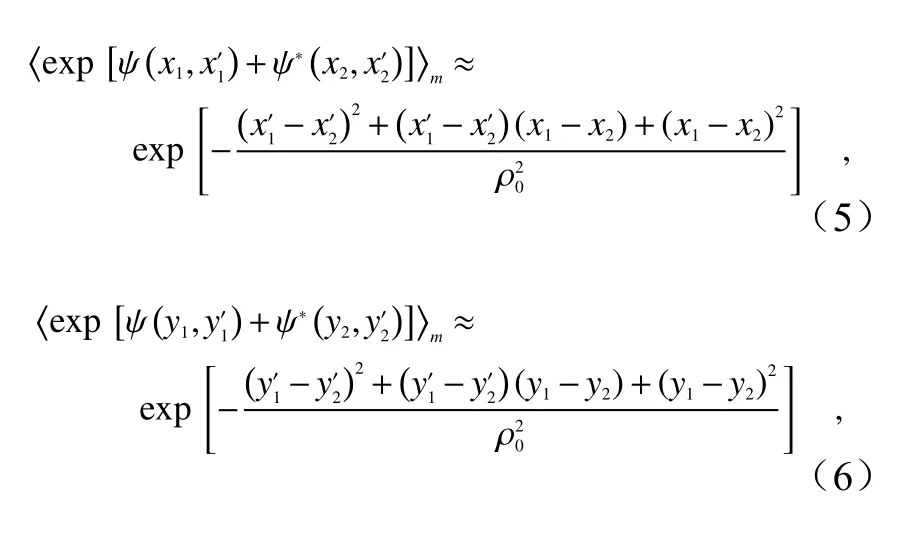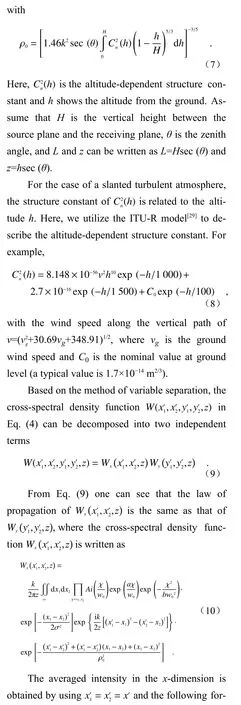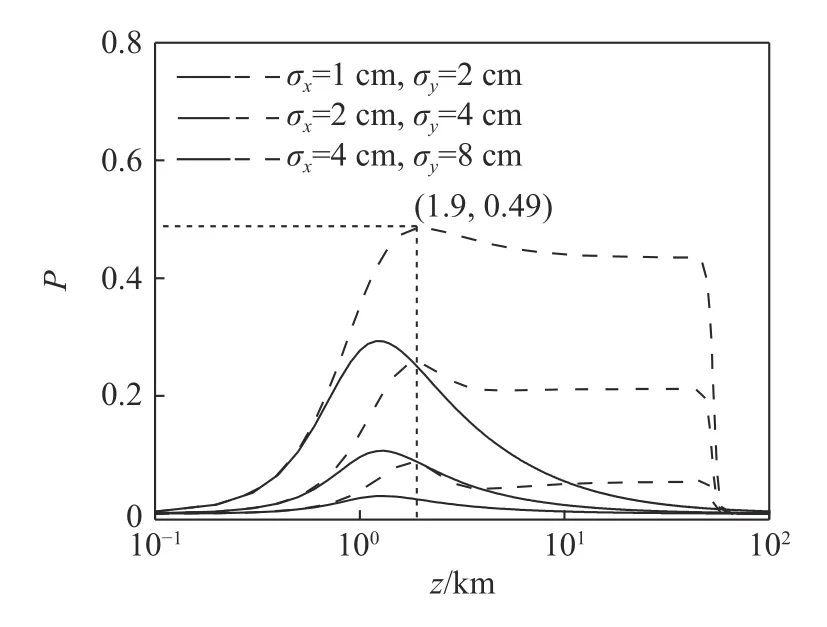Polarization changes of partially-coherent Airy-Gaussian beams in a slanted turbulent atmosphere
2021-04-20CHENGKeLUGangZHUBoyuanSHULingyun
CHENG Ke,LU Gang,ZHU Bo-yuan,SHU Ling-yun
(College of Optoelectronic Engineering, Chengdu University of Information Technology, Chengdu 610225, China)
Abstract:Investigating polarization changes in a turbulent atmosphere holds great significance because polarization is one of the most important parameters in laser communication.Based on the extended Huygens-Fresnel principle and the unified theory of coherence and polarization,an analytical expression for the degree of polarization(DoP)in partially-coherent Airy-Gaussian beams propagating in a slanted turbulent atmosphere is derived.It is then used to study the dependence of polarization changes in turbulent parameter,coherence length,zenith angle,truncation and distribution factor.The polarization between the slanted and horizontal paths is also compared.Compared with horizontal turbulence,the beams traverse a longer distance to recover their initial polarization in slanted turbulence.An increase in the zenith angle,receiving height and truncation factor,or a decrease in the coherence length can increase the DoP.A smaller distribution factor or a higher coherence length is beneficial to reducing the effect of the zenith angle on the polarization.Analysis of the influence of the distribution factor on polarization also shows that maintaining the polarization of a Gaussian beam with higher coherence in a horizontally turbulent atmosphere has a greater advantage to that of a pure Airy beam from the view of keeping polarization invariance.The results show that optical information encoding can be achieved by selecting appropriate parameters,which is useful for studying atmospheric communication.
Key words:degree of polarization;airy-gaussian beams;turbulent atmosphere;propagation
1 Introduction
The polarization properties of fully coherent and partially coherent beams in the turbulent atmosphere have been extensively studied owing to their potential applications in atmospheric communication and laser detection[1-8].This is especially true for the polarization changes of partially coherent beams passing through different media,which can be described using the unified theory of coherence and polarization[1-2].The polarization characteristic is an important parameter of a laser beam,which is used to code information in signal transmissions[9].Tremendous effort has been devoted to elucidate the effect of atmospheric turbulence,coherence length and aperture diffraction on the polarization changes or spectral properties of different laser beams[10-12],and to explore the condition of polarization maintenance in turbulent atmospheres[3].Likewise,propagation and controlling of a diffraction-free Airy beam in many linear media have been extensively investigated,owing to its self-healing and selfbending properties[13-17].Furthermore,Airy beams modulated by a Gaussian factor,Hermite function,Bessel wave or vortex core have also been proposed from theoretical and experimental perspectives[18-25].For example,the Airy-Gaussian beam can be regarded as an Airy beam limited by a Gaussian factor.Bandreset al.[18]described the propagation of a generalized Airy-Gaussian beam in ABCD optical systems.The propagation properties or momentum evolution of an Airy-Gaussian beam in quadratic-index medium,Kerr medium,uniaxial crystals and left-handed materials were further studied by Denget al.[19,21-23].The effect of coherence length,the truncation parameter and propagation distance on polarization maintenance in an Airy beam in a horizontally turbulent atmosphere was numerically analyzed by Yanget al.[26].However,in a slanted turbulent atmosphere the competitive relationship between a Gaussian factor and an Airy function,and the influence of coherence and zenith angle on the DoP are worthy of further investigation.
The main purpose of this paper is to explore the polarization changes of partially a coherent Airy-Gaussian beams passing through a slanted turbulent atmosphere that results from the propagation of the actual light wave in optical communication being a slanted rather than horizontal.The dependence of polarization maintenance on the turbulent parameter,coherence length,zenith angle,truncation factor and distribution factor is further analyzed,and the comparison is made for the DoP between Gaussian and non-diffraction Airy beams.The findings in this paper provide the possibility for laser detection,laser imaging radar and atmospheric communication using a partially coherent Airy-Gaussian beam.
2 Cross-spectral density matrix of partially coherent Airy-Gaussian beams
Assume that the electric field of an Airy-Gaussian beam atz=0 in the Cartesian coordinate is expressed as[21]

whereAiis the Airy function,w0represents the transverse scale of the Airy beam andadenotes a positive exponential truncation factor.The parameterbrepresents the distribution factor,which can cause the Airy-Gaussian beam to evolve into a pure Airy beam when it is larger,or a Gaussian beam when it is smaller.
According to the expression for the electric field in Eq.(1),the cross-spectral density function of partially coherent Airy-Gaussian beams in the plane ofz=0 can be described by[27]

whereμ(·)is spatial coherence and can be expressed by the Schell-model correlator

withσbeing the coherence length.Based on the extended Huygens-Fresnel principle[27],the cross-spectral density function in the receiving plane of partially coherent Airy-Gaussian beams propagating in a turbulent atmosphere can be expressed as

wherekis the wavenumber related to the wavelengthλandk=2π/λ,ψ()is the phase function depending on the properties of the medium,〈〉mspecifies the ensemble average of the turbulent medium,and is given by[28]



After tedious integral calculations,the averaged intensity in thex-dimension is obtained as


where the non-diagonal elements are arranged as zero,i.e.,Wxy(xʹ,yʹ,z)=Wyx(xʹ,yʹ,z)=0.Therefore,the expression of the degree of polarization can be simplified as


By substituting Eqs.(24)~(29)into Eq.(23),one can find that the DoP for partially coherent Airy-Gaussian beams depends on the truncation factor,distribution factor,zenith angle and coherence length.Details will be shown through numerical examples in the following sections.
3 Degree of polarization
Based on the analytical expression of the DoP in section 2,numerical calculations are performed to illustrate the polarization changes in a turbulent atmosphere.The calculation parametersa=0.1,b=10,λ=633 nm,σx=1 cm,σy=2 cm,θ=60˚andH=500 m remain fixed unless otherwise stated.
Fig.1(Color online)describes the DoP of partially coherent Airy-Gaussian beams passing horizontally through a turbulent atmosphere for different refractive index structure parameters.One can see that the DoP firstly increases and then decreases during propagation in a turbulent atmosphere.Most notably,if the partially coherent Airy-Gaussian beam travels a sufficiently long distance in a turbulent atmosphere,it becomes completely unpolarized,yet in free space,the polarization maintains a value ofP=0.85 after a long propagation distance.In comparison,a weaker turbulent parameter over a smaller distance can acquire a larger peak of polarization and has greater difficulty restoring the initial polarization at the source plane.Polarization changes can be considered sensitive to different turbulence values and coherence lengths,meaning that polarization changes have spatial coherence properties when a laser propagates in a turbulent atmosphere.Maintaining consistent polarization in stronger turbulence is important for laser communications.

Fig.1 The DoP of a partially coherent Airy-Gaussian beam passing horizontally through a turbulent atmosphere versus propagation distance
The effect of the zenith angle on the DoP of partially coherent Airy-Gaussian beams with varying parameters is further shown in Fig.2(Color online).It is clearly seen that an increase of the DoP is accompanied by an increase in zenith angle.A higher receiving height,a larger truncation factor or a lower coherence length can lead to an increase in the DoP.There exist critical valuesθcfor different distribution factors.For example,the critical value ofθc=53˚in Fig.2(c),the larger distribution factors acquire the smaller polarization whereθ<θc,while the opposite is true whenθ>θc.As shown inb=1 in Fig.2(c)andσx=4 cm andσy=8 cm in Fig.2(d),these changes in the DoP are both small fromθ=0 to 80˚,which indicates that a smaller distribution factor or a higher coherence length is beneficial for reducing the effect of zenith angle on polarization.

Fig.2 Change of the DoP in partially coherent Airy-Gaussian beams in a slanted turbulence atmosphere over the zenith angle with varying parameters.The fixed parameters areC0=1.7×10−14m2/3andz=10 km.
Fig.3(Color online)describes the dependence of the DoP for partially coherent Airy-Gaussian beams on coherence length for slanted and horizontal atmospheric turbulence.For the slanted path,the DoP also increases and then decreases to a stable value,where this stable value can be maintained until it finally decreases to zero for sufficiently long distances.For example,the polarization in the slanted path increases to a peak value ofP=0.49 atz=1.9 km and maintains the value ofP=0.42 with an increase in propagation distance,as shown inσx=1 cm andσy=2 cm in Fig.3.Likewise,the horizontal path has its peak polarization at 1.26 km.The slanted path can have stronger polarization in comparison to the horizontal path.The change in the DoP for a larger coherence is less than that of a smaller coherence length,and compared with a slanted path,the change in the DoP in the horizontal path is also small,which indicates that the beam with a higher coherence or horizontal path is more applicable for maintaining its initial polarization in optical signal transmission.

Fig.3 Change in DoP for partially coherent Airy-Gaussian beams over propagation distancezfor different coherence lengths,where solid and dashed lines show a horizontal and slanted path,respectively.The other parameters area=0.05,b=20,H=10 000 m andCn2=10−14m2/3.
The dependence of the DoP for partially coherent Airy-Gaussian beams on truncation factor and the distribution factor for slanted and horizontal atmospheric turbulence is also plotted in Figs.4(a)and(b)(Color online),respectively.It can be seen that a larger truncation factor or distribution factor can increase the maximal polarization of the Airy-Gaussian beams,which also leads to a larger difference between turbulence polarization and its initial polarization.Compared with a horizontal path,a slanted path at its maximal value needs a longer distance.For example,the propagation distances arez=1.25 km ina=0.01 andz=2.35 km ina=0.2 of Fig.4(a),respectively.From Fig.4(b)one can see that the polarization in slanted turbulence is sensitive to the distribution factor.A larger distribution factor can greatly increase the peak of polarization,and also results in the destabilization of polarization during propagation.A lower distribution factor causes an Airy-Gaussian beam to evolve into a Gaussian beam,which indicates that the polarization maintenance of a Gaussian beam in a horizontally turbulent atmosphere has an advantage over that of a pure Airy beam.The physical reason may be associated with the optical properties of Airy beams,such as their main-lobe and side-lobe structures,their self-healing abilities,the fact that they are diffraction-free,and their relatively complex spatial structures and propagation properties when compared to those of a Gaussian beam.

Fig.4 Change in DoP for partially coherent Airy-Gaussian beams over propagation distancezfor different truncation or distribution factors,where the solid and dash lines show the horizontal and slanted paths,respectively.The fixed parameters are(a)b=20,H=10 000 m andCn2=10−14m2/3;(b)a=0.05,H=10 000 m andCn2=10−14m2/3.
4 Conclusion
Based on the extended Huygens-Fresnel principle,the analytical expressions of cross-spectral density for partially coherent Airy-Gaussian beams propagating in a turbulent atmosphere is derived and used to investigate the effects of the turbulent parameter,zenith angle,truncation factor,distribution factor and propagation path on the degree of polarization in the unified theory of coherence and polarization.It has been shown that a weaker turbulent parameter keeps polarization invariance less effectively in comparison to a stronger turbulent parameter.An increase in zenith angle,receiving height,truncation factor and a decreases in coherence length can increase the degree of polarization,and a smaller distribution factor or a higher coherence length is beneficial to reducing the effect of zenith angle on the polarization.The analysis shows that polarization maintenance in a Gaussian beam with higher coherence in horizontally turbulent atmospheres has greater advantages to that of a pure Airy beam when analyzed for polarization invariance.The results show that optical information transmission and encoding can be achieved by selecting appropriate parameters,which is useful for studies in atmospheric communication and environment detection.
杂志排行
中国光学的其它文章
- Line-scanning confocal microscopic imaging based on virtual structured modulation
- Enhanced dye-sensitized up-conversion luminescence of neodymium-sensitized multi-shell nanostructures
- Hybrid plasmonic leaky-mode lasing on subwavelength scale
- 10−9 量级高灵敏度点源透射比测试设备研究
- 大孔径静态干涉成像光谱仪径向畸变导致的谱线偏移误差的校正
- 表面损伤衍射双向反射分布函数模型建立及分析
